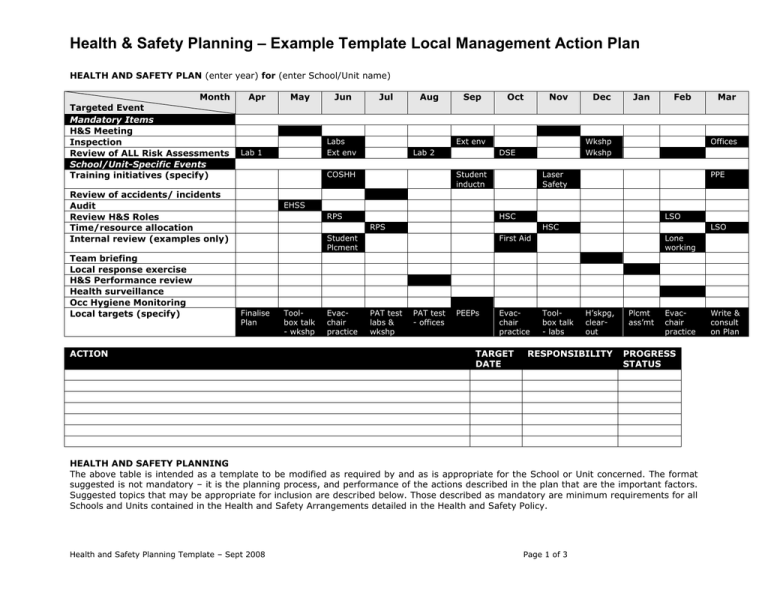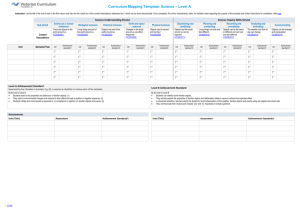– Example Template Local Management Action Plan Health & Safety Planning
advertisement

Health & Safety Planning – Example Template Local Management Action Plan HEALTH AND SAFETY PLAN (enter year) for (enter School/Unit name) Month Targeted Event Mandatory Items H&S Meeting Inspection Review of ALL Risk Assessments School/Unit-Specific Events Training initiatives (specify) Apr Jun Jul Labs Ext env Lab 1 Aug Sep Oct Nov Ext env Lab 2 COSHH Review of accidents/ incidents Audit Review H&S Roles Time/resource allocation Internal review (examples only) Team briefing Local response exercise H&S Performance review Health surveillance Occ Hygiene Monitoring Local targets (specify) May Dec Jan Feb Wkshp Wkshp DSE Student inductn Mar Offices Laser Safety PPE EHSS RPS HSC LSO RPS HSC Student Plcment Finalise Plan ACTION Toolbox talk - wkshp Evacchair practice LSO First Aid PAT test labs & wkshp PAT test - offices PEEPs Evacchair practice TARGET DATE Lone working Toolbox talk - labs H’skpg, clearout RESPONSIBILITY Plcmt ass’mt Evacchair practice PROGRESS STATUS HEALTH AND SAFETY PLANNING The above table is intended as a template to be modified as required by and as is appropriate for the School or Unit concerned. The format suggested is not mandatory – it is the planning process, and performance of the actions described in the plan that are the important factors. Suggested topics that may be appropriate for inclusion are described below. Those described as mandatory are minimum requirements for all Schools and Units contained in the Health and Safety Arrangements detailed in the Health and Safety Policy. Health and Safety Planning Template – Sept 2008 Page 1 of 3 Write & consult on Plan Health & Safety Planning – Example Template Local Management Action Plan MANDATORY ELEMENTS Health and Safety Meetings Meetings should address health and safety issues at least once per year. In low hazard Schools, this can be achieved by a separate agenda item – preferably first to demonstrate commitment – at an appropriate existing meeting. In higher hazard Schools and Units, consideration should be given to holding a separate health and safety meeting. Inspections All areas under the control of the School or Unit should be inspected at least annually. For higher hazard areas, it may be appropriate for inspections to be planned more frequently. Risk Assessments All hazardous activities should by now have a risk assessment in place (if this is not the case it should be addressed as a matter of urgency), and these need to be reviewed or their validity verified on an annual basis. Lower hazard areas such as offices may have no requirement for specific risk assessments, other than for display screen equipment, and this should have been verified on inspection. All risk assessments should be reviewed, including COSHH, DSE, manual handling, PUWER, noise etc. assessments. This should include a review of the validity of any underpinning documentation referred to in the assessment, e.g. material safety data sheets, laboratory protocols and SOPs. DISCRETIONARY ELEMENTS Training Initiatives Basic health and safety training requirements should be informed by the risk assessments for the task or key competencies required for a role. It is good practice to expand this by plotting roles against any training requirements in a matrix format, and addressing any gaps identified. Health and safety training may also be needed to raise awareness amongst groups of staff – either in general, or to address specific issues – identified in a number of ways from formal inspection, supervisory observation of behaviours or simply the perception of staff members. It could be that information or instruction would suffice, but if the issue runs deeper and training is appropriate it should be planned. Incident Review It is good practice for Heads of Schools and Units to be informed of all accidents and safety incidents, and to maintain an overview of developing trends in order to plan appropriate action. The mechanisms required to achieve this will vary with risk and scale. Audit Audits will be performed by the EHSS Unit to a process and frequency described in the Audit Policy Team Briefing If team briefings or full School or Departmental meetings are held, it is good practice to include a health and safety topic on the agenda and invite feedback on health and safety standards generally. Many “blue chip” companies insist that health and safety is first on the agenda at these briefings and meetings. Local Emergency Response Arrangements may already be in place for a number of issues critical to core business delivery, and these may be well tested. However, where other emergency arrangements are in place or required they are unlikely to run smoothly unless they too are well tested, reviewed, Health and Safety Planning Template – Sept 2008 Page 2 of 3 Health & Safety Planning – Example Template Local Management Action Plan amended and then tested again periodically. Examples may include lone working arrangements; panic alarms for cash handling; potentially confrontational situations and other foreseeable emergencies identified on risk assessment. Performance Review No criteria have yet been set. This may be required in future, with criteria likely to centre around the corporate strategic objectives, and any related performance targets set for health and safety. Currently it would be appropriate simply to review performance against this Health and Safety Plan. Health Surveillance This will have been identified following risk assessment – most commonly COSHH, noise and vibration. Occupational Hygiene Any requirement for and frequency of monitoring for airborne contaminants will have been identified on COSHH assessment. Other Initiatives will vary between Schools and Units. Health and Safety Planning Template – Sept 2008 Page 3 of 3

